Degreasing is one of the most confusing and frustrating steps in cleaning and whitening animal bones. It isn’t always necessary but, if the bones are yellow, shiny, and stink, then you probably need to degrease them.
Need more help? Read my post on how to remove tissue and how to whiten animal bones.
What Is Degreasing?
Surprisingly, some bones can contain a lot of fat. This is because bones are actually little “factories” which produce blood cells in their marrow. Guess what marrow contains? Lots of fat!
Degreasing is a process in which you remove fat trapped inside animal bones. If you don’t degrease bones, the fat will eventually leak out of the bones and cause them to turn yellow. In some cases, the fat starts to go bad and will rot the bones (hence the bad smells!).
When Is Degreasing Necessary?
Much of the time, degreasing isn’t necessary. The same microbes which eat tissue (read how to remove tissue off of bones) will also eat fat in the bone.
However, there are some situations where degreasing is almost certain to be necessary:
1: You Boiled the Bones
As I explained in the post about removing tissue, you should never boil bones. There is a lot of fat in animal hide and tissue. This fat gets in the boil water, and then the fat gets absorbed into the bone. Once the fat is in the bone, it is very difficult to remove!
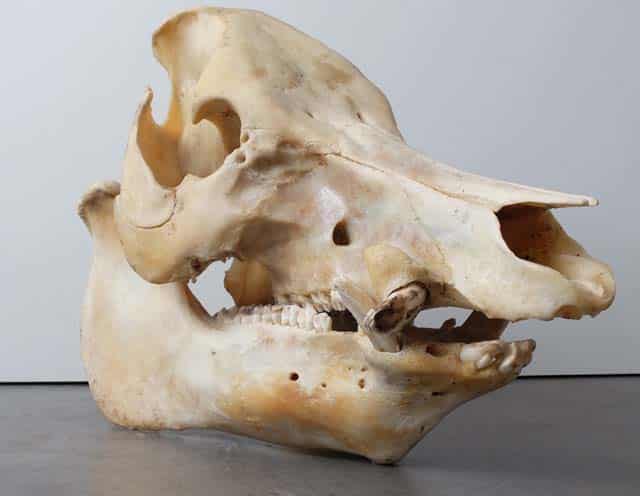
Check out all the gross yellow grase spots on this pig skull which was boiled.
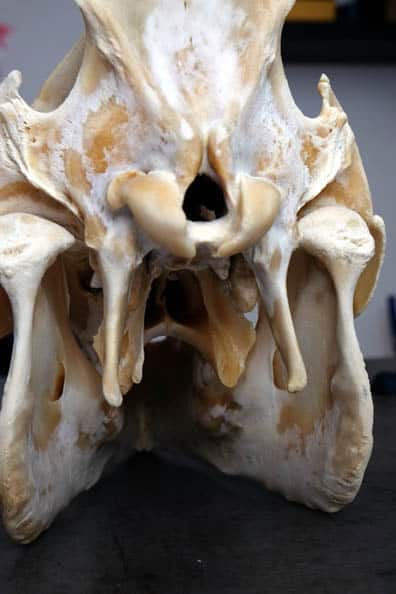
Here’s the back of the skull after a few days of degreasing. Look at all those greasy spots!
2: Certain Types of Animals
Some animal bones are greasy by nature. These bones almost always need to be degreased or they will stink to high heaven. The list includes:
- Bears
- Opossums
- Pigs and wild boars
- Seals
- Whales
- Elephant feet
- Young animals
- Vertebrae
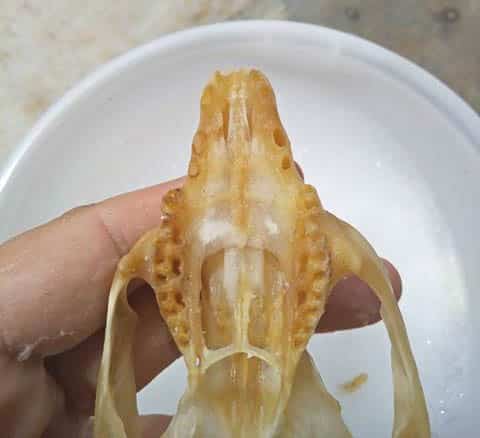
Check out how greasy this possom skull is! Unfortunately, the grease starting rotting and the skull stunk so badly it had to be thrown away.
How to Degrease Bones
Some professional taxidermists will use gasoline or camp-stove fuel to get the fat out of animal bones. However, these substances can be dangerous so I didn’t include them here. Below are the easiest and safest methods for degreasing bones.
Method 1: Soapy Water
This is by far the easiest and cheapest method of getting fat out of bones – especially for amateurs.
Dawn dish soap works really well. Don’t use powdered dishwashing detergent meant for machines. Also don’t try to use chemical degreasers, like stove degreaser. It will literally dissolve bones.
Steps:
- Put the bones in a bucket with soapy water. Use lots of soap.
- Let soak.
- When the water starts turning murky or gets globs of grease floating on top of it, dump the water and start again.
Tip:
For degreasing to work, the water needs to be warm. Otherwise the fat won’t break down and be able to leach out of the bone. The ideal water temperature is around 80-115F (26.6-46C). To get the water to stay warm you can buy an aquarium heater and put it in the bucket with your bones. You can also get bucket heaters from farm supply stores.
Method 2: Ammonia
Ammonia is a great degreasing agent and has the benefit of being cheap. You can often find it in hardware stores. Just make sure that you get the clear ammonia and not one that is colored as it might have additives which can harm the bone.
Most ammonia in stores is 2.5% strength. This can be diluted to a ratio of ½ gallon of ammonia to 10 gallons of water. If you get 10% ammonia, then you’ll use a ratio of 1/2 quart of ammonia to 10 gallons of water.
The problem with using ammonia for degreasing is that it has strong fumes. You must do this outdoors! You also must wear a respirator mask AND eye protection. It is very dangerous to get ammonia in your eyes. So, even if you feel stupid wearing goggles, put them on!!!
Disposing of Ammonia:
Ammonia can *usually* be dumped down the sink or toilet. You can even dump ammonia out on your yard. It will probably kill any plants that it comes in contact with though, so be careful where you dump it.
The exception is if you have a septic system. In this case, don’t dump it down the drain, toilet, or on your yard. Ammonia could end up in the ground water and ultimately into your well. If you have a septic system, then it’s probably best to avoid using ammonia.
Method 3: Acetone
Acetone is also a great degreaser, but is probably too difficult for amateurs to work with. First off, acetone is expensive and harder to get. Paint thinner (which is mostly acetone) will work, but some paint thinners may contain additives which could harm the bone.
Acetone cannot be diluted. You have to soak the bones in straight-up acetone. That means you’ll need a lot of it for larger bones, so it can end up being very expensive. However, acetone can be reused: just skim/filter the fat out of it and reuse the acetone with your next greasy bones.
Another issue is that acetone is potentially dangerous. It should NOT be heated as it is highly flammable. It also produces noxious fumes which should not be breathed in. You must use acetone outdoors and while wearing a face respirator.
The biggest deal breaker with acetone is that you can’t dump it down the drain. It must be bottled and taken to a disposal facility. For me, this makes it too much of a pain to bother with.
| IMPORTANT: Acetone and hydrogen peroxide do NOT mix. The combination can be EXPLOSIVE. If you use acetone on the bones, then you’ll want to wash the bones and completely dry them before you whiten them with hydrogen peroxide. |
How Long Will Degreasing Take?
As I mentioned before, degreasing is the most frustrating part of cleaning bones. Really greasy animals like bears can take months to finish. My pig skull took 2 months of soaking in soapy water before the grease got out.
Even with the same type of animal the degreasing time can vary. For example, a bear which ate a really fatty diet might take longer to degrease than a bear which didn’t.
The degreasing time varies so much that professional taxidermists (the good ones at least) will never guarantee a skull mount will be finished by a certain time.
The best advice I can give you is this: Be patient. As the professionals say, “It’s done when it’s done.”
How Will You Know Degreasing Is Finished?
Here are signs degreasing is done:
- The water stops getting murky when you soak the bone
- There are no more yellow or shiny spots on the bone
One tip is this: If you aren’t sure whether the bone is fully degreased, do a soak in hydrogen peroxide. This will whiten the bone and allow you to see grease spots easier. Plus, you’ll be better able to tell whether the yellow spot is a dirt stain or grease stain.
Below are some before/after of degreased and whitened bones.
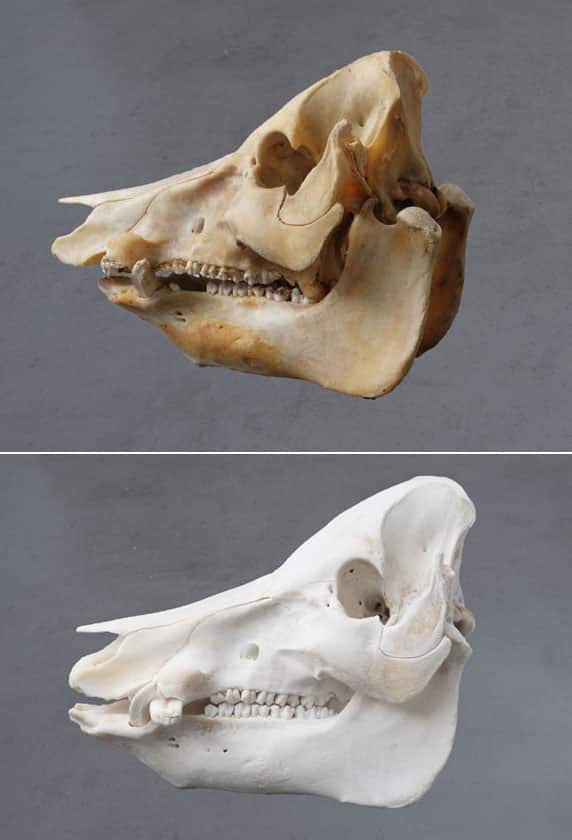
Here’s the pig skull after 2 months of degreasing and then whitening with hydrogen peroxide.

This vertebrae stunk like crazy. Notice the shiny parts on the before picture. After degreasing in acetone, it stopped stinking.
Want more info on cleaingn bones? Get my eBook here for $4.99. You’ll get all sorts of expert tips that even amateurs can use.


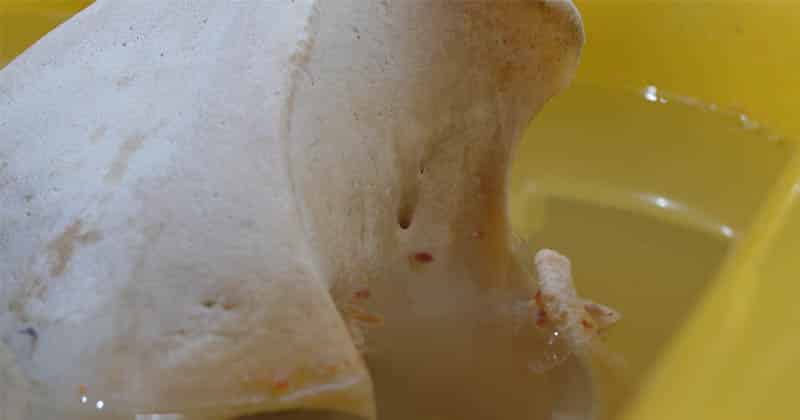
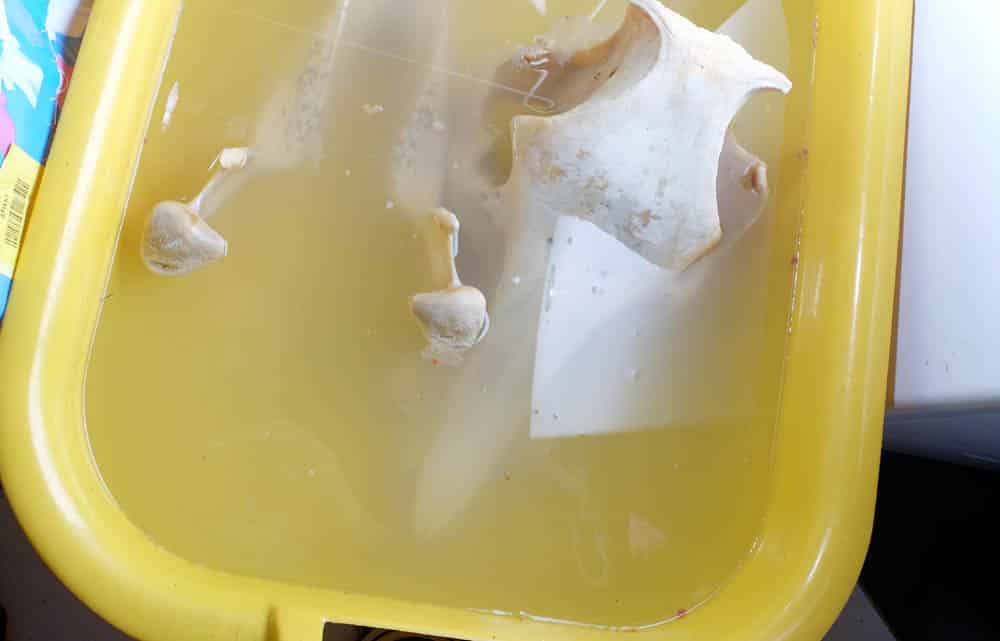
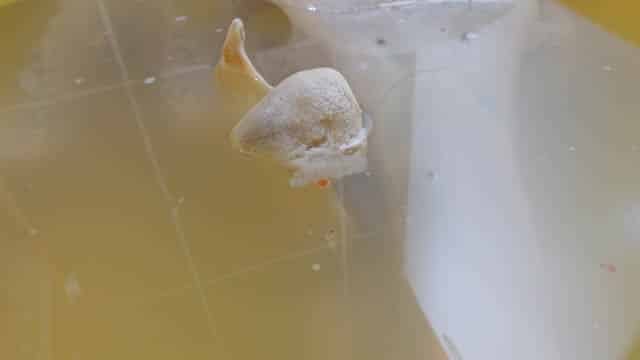
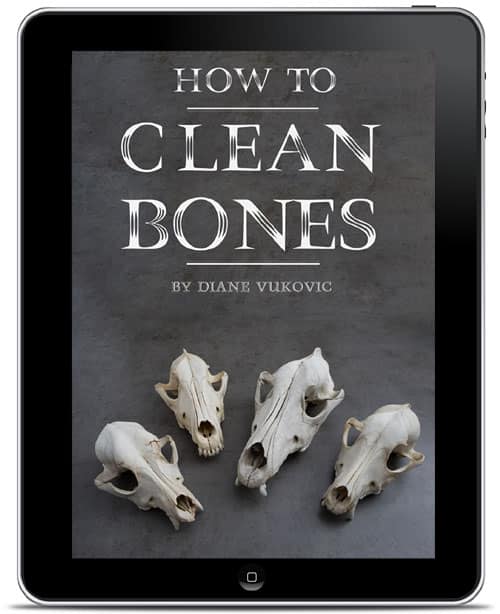










48 Comments
Pamela P.
April 24, 2020 at 6:38 pmHi Diane, I bought your ebook to find out about whitening antlers as I am a silversmith and I am wanting to whiten some antlers that I am carving to use in my work. However in your ebook you state to not whiten antlers…..is that a personal preference for how their look on a skull? I don’t intend to use them in a skull mount, so can they be whitened without damage to the antlers…..I already purchased the 12% peroxide based on your recommendations and hopefully I haven’t wasted the 25. bucks! Thank you for a reply 🙂
Diane
April 25, 2020 at 11:13 amYes, you can whiten the antlers if you want to. They will just lose their natural look, so it’s a personal choice.
Justin
November 5, 2021 at 9:32 pmHi Diane,
I have a question. I’m trying to display a catfish skull, I let it soak for months in soapy water, and now put it in peroxide to whiten, but it still have a lot of yellow spots. Can this mean there’s still grease in the bones? I want to be sure before putting it a shadow box and risking it rotting. I want to try the acetone method just to be sure, but like I said, I already soaked it in peroxide, is it safe to put in acetone after I wash it off from the peroxide soak?
Diane
November 8, 2021 at 3:29 pmCatfish skulls are really awesome. 🙂 Mixing hydrogen peroxide and acetone is dangerous. But the H202 airs off pretty quickly. So just let the skull completely dry and wait a day or two for good measure. Then you can do the acetone soak.
Are you sure the yellow spots are from fat? They might just be stains. Fat spots look translucent or shiny. If it seems more like stains, I personally would do another quick soak in H202 and see if the spots lighten. Also pay attention to whether there is still ligament tissue on the skull. That often looks yellow.
Justin Lillies
November 23, 2021 at 2:48 pmThank you so much! Now that you mention it, maybe it could be stains, I will try the re-soak in peroxide. Thanks again Diane 🙂 🙂
Audrey
February 27, 2021 at 11:32 pmI have a really stinky raccoon skeleton that has been soaking in enzymatic detergent and water for the last 3 weeks or so. It reeks, so I think I will need to degrease.
I live in a cold climate, so keeping soapy water warm for an extended period of time is unrealistic. I think I will go the ammonia method. I currently have the bones in a gallon-sized mason jar with a lid, so I am planning on using that same jar to use with the ammonia. That way the fumes won’t be such an issue.
My question is– is there any issue with doing that? Does it need to be stored at a specific temperature when using ammonia? I will be setting it up outside, but then I’ll bring it back indoors when the jar is sealed.
If I do it outside and just work quickly with goggles, can I skip the respirator? Do I need to refresh/replace the ammonia solution while the bones soak for a month or however long it takes?
I’ve had a hard time finding much info on degreasing with ammonia, so your post is very much appreciated. Thank you!
Audrey
February 27, 2021 at 11:34 pmThe possum skull that was thrown out because of the rotting grease– was degreasing not enough to fix the problem? Are there solutions to this issue?
I’m worried that could be the case with my stinky raccoon skull, but I really don’t want to toss it out. This is my first project and besides the smell, it’s in amazing condition.
Diane
February 28, 2021 at 10:13 pmA few things:
-Is it an enzymatic detergent like Biotex? Or is it a normal clothes-cleaning detergent which also has enzymes? Because most detergents will break down the bones. It can seriously stink as it does and cause permanent damage. 🙁
-Check inside the brain cavity. Sometimes tissue gets stuck there and stinks like crazy. Also poke into the foramina (nerve holes) to see if some tissue comes out. There is usually some nastiness hidden underneath the teeth too, but those can be really difficult to remove without breaking them.
-Before you try the ammonia method, maybe let the skull COMPLETELY dry. See if the smell goes away. Also see if there are clearish spots on the skull when it is dry. You can also do a soak in diluted hydrogen peroxide before continuing with the degreasing. The hydrogen peroxide will help you see any lingering grease spots better. I also feel that hydrogen peroxide helps loosen the grease a bit so the next round of degreasing is easier (this is debatable though).
-Only use ammonia outside. Wear the respirator (or at least an N95 mask) and the goggles. Ammonia freezes at something like -100F. So you don’t have to worry about it freezing even in the cold.
-You can use the same jar for the ammonia. Just make sure it is completely cleaned out. You don’t want the ammonia to react with whatever is in the detergent.
-Change the ammonia when it gets nasty. You might even see grease chunks floating to the top.
-As for that possum skull, the fats in the skull had already started to break down (go rancid). It was too far gone to save it.
Hope this helps!
Anna
October 18, 2023 at 5:52 pmHi Diane!
Tha k you for all these instructions! I boiled and bleached some chicken bones from a Rotisserie chicken. Do you think they are safe to use, or should I try to soak them in soap to get any grease out of them? They look dry and white.
Diane
October 19, 2023 at 12:31 pmIf they look dry and white, I’d just leave them be. It’s not like chicken bones are ultra-rare and you can’t just get some more 🙂 But if you want to make something from them, it would be best to use bones which weren’t cooked or boiled.
Elián
July 20, 2021 at 6:03 pmHi Diane, I’m wondering about the following thing you said (I cite): “If you aren’t sure whether the bone is fully degreased, do a soak in hydrogen peroxide. This will whiten the bone and allow you to see grease spots easier. Plus, you’ll be better able to tell whether the yellow spot is a dirt stain or grease stain”. Then, peroxide seems to be pretty reliable to know if the bone needs to be degreased or not, right? So why not soaking the bone directly in peroxide, skipping the degreasing step, and doing the degrease after that if the bone shows any stain? That would avoid spending more time and resources than are needed if the bone actually doesn’t have any fat. What are your thoughts?
Diane
July 21, 2021 at 8:13 amYou really shouldn’t skip the degreasing step. Most bones are going to have some fat. Even if they aren’t greasy, the degreasing helps get other nastiness out of the bone. This ultimately means the H202 can do a better job and you won’t have to do as many soaks to get to your desired level of whiteness/get stains out. Since the H202 is the expensive part of the project, it’s better to save on that than on dish soap.
It can sometimes be really hard to tell whether a bone is greasy or just has stains on it. If it lightens with the h202, then you know it is a stain and not grease so can just move on. If it’s grease though, you can be in for a serious challenge. People go crazy trying to degrease possoms, pigs, bears, and other greasy bones!
Laura
September 24, 2021 at 8:18 pmHi there-
I had a total hip replacement, and kept my femur head – a round bone at the top of the thigh bone. anyway – I have boiled (!), then soaked in clear ammonia/ water solution, now I’m soaking in hydrogen peroxide.
I noticed after the ammonia mix – I left out in the sun to let the heat/ sun do it’s work, but the bone is still sticky. ugh. Thoughts?
Laura
September 24, 2021 at 8:19 pmI forgot to mention that the hydrogen peroxide is bubbling, like it’s suppose to, and I guess this is expected in this process?
thanks!
Diane
September 30, 2021 at 12:51 pmAmmonia can leave a bit of a sticky residue. Or the stickiness might have been from fats coming out of the bone. In either case, it’s nothing to be concerned about. However, you didn’t have to expose the bone to UV light after the ammonnia soak. The UV light is for after the hydrogen peroxide soak. It really helps with whitening.
Btw, that’s friggin’ amazing that you got to keep your femur bone!! I hope it cleans up nicely 🙂
Brian
February 5, 2022 at 3:14 amWhen it comes to degreasing the bones with dishwashing detergent, is there a ratio you recommend? I’m something of an “over-doer” with the Dawn when it comes to washing dishes. Is it possible to over-do it in this case?
Diane
February 8, 2022 at 5:22 pmthe ratio really doesn’t matter. just put some warm water in the container, add a big squeeze of soap, mix and add the skull. add more water if the water doesn’t fully cover the skull. You really can’t over-do it.
Kim
March 24, 2022 at 7:00 pmHi, I’m trying to clean up some bird bones and there seems to be a bit of grease in them. I stuck them in ethanol overnight, and then warm soapy water like you mentioned; they aren’t super greasy but smell funny if I put my nose close to them.
I left some of the ligaments connecting the bones in place to make my work easier; could that be the reason?
Would that be a problem later, or could I just dry them after this soapwater session and move on to the hydrogen peroxide?
I remember cleaning up a boiled chicken bone from my dinner when I was smaller; I probably didn’t clean it thoroughly but there was no problem after it dried. Would a wild bird’s bones be different or can I apply the same logic here?
Diane
March 25, 2022 at 12:48 pmYes, the ligaments might be making it smell bad. You are smart to want to leave the ligaments in place. It’s called a “ligament mount” and it involves using H2o2 to get the flesh off without messing up the ligaments. This method is really tricky though and there isn’t an established “best” way to do it. I also haven’t experimented with it too much (I find bird feet particularly disgusting to clean!). This guy has lots of good information about how to do it though: https://www.theboneman.com/skeletoncleaningoxidationmethod
Alex
March 28, 2022 at 2:02 amHi, I found a bear skull in the woods that I am trying to preserve. I work in a lab so I have easy access to acetone and acetone disposal, so I am going to use the acetone degrease method. I have soaked it for one week already, but it is still yellowish. How long should the degreasing take with acetone? Is there a way to easily tell the difference between grease yellow vs staining yellow that H2O2 will remove?
Thanks!
Diane
March 29, 2022 at 2:49 pmBear skulls are notoriously greasy. It can take months of degreasing (though it shouldn’t take that long with acetone). Basically, keep soaking it in degreaser, changing the liquid occassionally, until it doesn’t turn yellow anymore.
You can take a break from degreasing and do a H202 bath. It helps you see whether any yellowness is grease or just statins. If it’s greasy, you just start degreasing again.
Sometimes you think you are done degreasing and then yellow stains show up. This is the fat migrating out of the bones.
If you are impatient, I know one professional taxidermist does this: he degreases for a while, whitens with H202, and then gives the bone to the client with instructions to come back in a year or two if the skull starts getting yellow.
Finn
April 29, 2022 at 5:48 amHi, I found this deer jawbone yesterday while creeking with my friend. I was just wondering about how long a deer bone might take. I know it varies from animal to animal, but I was just wondering how long I should keep it in the bucket of dish soap. This is the first time I found and kept a bone. What I’ve done so far is soak it in dish soap overnight, scrubbed it with a toothbrush and Scotch-Brite brush and changed out the water when I get home from school, and poured some water I boiled into a bucket of mostly room temperature water and dish soap, gauging with my hand how hot it was to make sure it’s not boiling. My current plan is to just change out the water as often as I can and hopefully sit down for abt an hour or so and give the bone a really good proper scrub in the dish soap tomorrow.
Diane
May 2, 2022 at 8:06 pmDeer bones are rarely greasy — especially if it wasn’t boiled or simmered with flesh on it. You can probably just degrease for a day or so. If there are oil-like blobs floating on top of the water, then you need to keep degreasing. Also, if you see any yellow or clear spots on the bone after doing a hydrogen peroxide soak, then you will need to degrease again. I doubt it will be necessary though. 🙂
Nor
September 18, 2022 at 10:12 pmI’m just wondering about Laura, who kept the head of her femur when she had a hip replacement. If she’s a possum, would that have changed your answer? I sort of suspect that she’s a bear; it would help if she would clarify that.
Diane
September 19, 2022 at 12:57 pmI’m pretty sure she is human 🙂 But if she were a bear or possum, my answer would have been this: those animals have really fatty bones. You need really need to degrease them a bit longer to get all the fat out!
Conor
November 26, 2022 at 9:13 pmDiane,
Are there any considerations when trying to preserve very fresh bones? I have femurs from a recently killed deer that I want to prepare and I was wondering if the freshness makes them harder to preserve and if so what do you recommend I do?
Thank you,
Diane
November 29, 2022 at 12:16 amThe freshness shouldn’t matter. Just be careful (and patient!!!) when getting rid of the flesh. If you boil or even simmer in very hot water, you’ll end up with lots of fat trapped in the bone. Femurs are great bones to start with, especially from deer since they aren’t very greasy animals. 🙂
Ineke
January 24, 2023 at 6:59 amHi Diane,
I am degreasing a buffalo skull and it’s taking ages. The head was boiled (not by me) and I’ve been changing the water every day to keep it very warm. I’m in Australia so it’s between 25 and 30 degrees (hot) during the day but cools overnight. I’ve been doing this since October with a three week break where I left it in the sun.
I’ve added a sous vide machine this week to keep it warm and have bleached it twice with hydrogen P as you suggest. Each time the bone went really white except for yellow stains in spots. Then when I go back to soaking in soapy water again the whole skull yellows. Should I move to acetone or keep at it?
Diane
January 24, 2023 at 3:33 pmThe reason it’s turning yellow again is probably because fat from inside the skull is seeping outwards. If you don’t care about the yellow spots, you can “give up” and just leave them. Buffalo skulls are really tough, so you won’t have to worry about the fat causing the skull to rot and fall apart. A few fatty areas shouldn’t cause any stinking.
Otherwise, be patient and keep on soaking. For your own sanity, you can switch to changing the water less frequently. Or try ammonia first since it’s cheaper and easier to dispose of.
Ineke
February 3, 2023 at 11:47 pmHi Diane,
I’m keeping at the soaking and it seems to be working a lot quicker with the sous vide which is keeping the water at 55 degrees c. I’m letting it go for 2 to 3 days before changing the water (which is still smelly so I have to keep going).
This last soak though, there have come up some grey, brown and almost green patches… is this normal?
Ineke
Diane
February 6, 2023 at 6:53 amThe grey/brown patches are normal. Sometimes it is pink. It’s usually bacteria which is eating the fat. Sometimes the entire bones will turn black or pink, but the color is easily removed during the hydrogen peroxide step. 🙂
Ineke
March 2, 2023 at 10:32 pmHi Diane,
I’ve been soaking the buffalo skull in soapy water at these high temps and the water stays clear for three days then on the fourth day goes murky and black bits appear(then it stinks).
I then do a hydrogen soak and it goes really white and looks awesome except for some orange bits at the back that look like the pics of the pig skull in your downloadable book.
At this point it doesn’t smell.
Then I do the hot water soak and the same thing happens….. clear for 3 days then goes murky, stinky and black.
Eventually I want to paint the skull. What do you think? Keep going?
Also, the skull seems to be dissolving a bit after each hydrogen soak…. I.e. small white powder comes off….
I also am treating the horns as per your instructions (washed and how filled with borax) but they are stinky too.
Ineke
Diane
March 3, 2023 at 9:49 amDon’t worry about the blackness (I’m going to write an article about this on the site soon). It’s just bacteria which start growing in the soak water and turns the bones black. Sometimes it’s pink bacteria instead of black. In either case, the bacteria goes away with the H202 and doesn’t come back.
If it’s just a little bit of yellow grease on the skull, you can just let it be. I’ve left some grease in skulls and they were fine — never started to stink later. The grease doesn’t look pretty, but you are going to paint over it anyway.
As for the stinky horms, get a pipe cleaner or one of those bottle cleaner things and reallly scrub inside. Make sure you get any last bits of gunk deep inside. Then fill them with baking soda for a few days to week. It’s normal for bones and horns to smell a bit funky while they are still wet. Once dry, any smell should go away.
Ana
March 3, 2023 at 8:20 pmHi Diane,
I’m new to degreasing but have been soaking a seal rib and vertebrae for about 3 ish months followed by a hydrogen peroxide soak. I recently checked on them and they look mostly clean, I did find a little bit of gelatinous texture on the vertebrae that I mostly got off with a toothbrush. How do I know when they are ready to be displayed? Do they need another soak just in case? The vertebrae was especially gelatinous when I first found it. They are still a bit stinky though the water isn’t especially cloudy, I was thinking about trying the baking soda trick in the last comment.
Thanks!!
Diane
March 14, 2023 at 10:21 amIt’s normal for bones to stink a bit when they are still wet (just like how wet dogs stink). But the bones shouldn’t stink when they are dry. If the water isn’t cloudy anymore and they don’t stink when dry, then it sounds like they are done. Seals are really greasy though. So don’t be surprised if the bones start getting yellowish down the line (from grease from deep inside the bones slowly making its way out). If this happens, you can always do another de-greasing. No big deal 🙂
Karen Torio
March 19, 2023 at 3:48 pmHi Diane,
Your thoughts about degreasing the bones were very helpful. I’m done with the process of hydrogen peroxide soak of my chicken bones and it’s perfectly clean and white. I will now do the acetone soak, for how long 24 hours or more? Thank you!!!
Diane
March 20, 2023 at 9:48 amUsually you would do the degreasing before whitening. If the bones are already white, then you probably don’t need to degrease at all. (Chicken bones aren’t that fatty). Sounds like you are done 🙂
Corin
April 20, 2023 at 4:33 pmI am wondering about the best way to handle a deer carcass-ribcage and pelvis , no extremities or head. There is not much flesh on the animal. And, of course it is fairly long. Any tips for the best way to start? Thanks.
Diane
April 20, 2023 at 5:58 pmDeer generally aren’t very greasy, so you might be able to skip degreasing completely. However, if you have vertebrae, these are greasy. Start with macerating to get the flesh off, then do a soak in soapy water to degrease. You can do a H202 soak after that. If there are yellowy spots after the H202 soak, then you know you need to degrease more. Hope that helps!
Corin
April 20, 2023 at 8:03 pmThank you, Diane. Do you have any recommendations for soaking such a long torso?
Diane
April 21, 2023 at 10:38 amYou will need to disassemble the bones first. This can be really tricky because the tissue holding them together is TOUGH. I recently did a cow vertebrae with ribs and had to soak it for two days just to soften the tissue enough to pull the vertebrae apart. Even then, some was too tough and I had to saw through bits of connective tissue with a serrated knife. Ended up with blisters on my fingers from doing this:p
Tip: Take photos before you disassemble. This will make it easier to reassemble later on!
*Some people leave the connective tissue on bones so they don’t have to reassemble the bones later (this is especially useful when dealing with tiny bones from animals like rodents but reassembling a deer torso shouldn’t be too tricky). This is called a “ligament mount.” Connective tissue is so tough that a lot of it stays put even after long maceration times and H202 soaks! For a deer, you’ll need a massive trash can for macerating and degreasing. But then you won’t be able to soak the bones in H202 since it would cost a fortune to fill a trash can with H202. Instead, you could use the “H202 + baking soda paste” method I talk about in my article about whitening bones.
Anne
April 21, 2023 at 3:20 pmHello, Laura,
It is such a treat finding your page. I am an artist and a long time collector of animal bones. Bones are wonderful to draw! When I was in art school, a classmate was pretty hard core in obtaining bones, and had them macerating in trash cans, on top of the art building (the south can be pretty hot and speed the process along nicely) to allow nature to take it’s course. For the most part I stuck to field bleached bones (cows and deer) and the bones of tiny creatures cleaned by insects, or occasionally a smal birdl carcass. My main concern was sanitizing them so that I could handle them and apparently along the way made EVERY mistake in the book, from chlorine bleach to caustic soda (for the carcasses) to boiling. In the last several years I have pretty much stuck to collecting tiny bird bones and the bones of small creatures, which have been cleaned by nature. But I was given deer bones, mostly field cleaned but still with bits of flesh and thanks to the internet have found many sites that describe better procedures for bone cleaning. And now I am interested in whitening the bones. Before I found your site, I read several articles and quickly learned about the damage chlorine bleach can render (pardon the pun) and the impact of boiling (which explains a few things!). A few suggested using enzymes to clean the bones of residual organic matter. This made sense to me, but then so did caustic soda for a fresh carcass). I couldn’t find a product name, however, and am aware that enzyme cleaners are available in many formulations. I already had a product called Bio-Kleen and decided to experiment with it on a few of the bones, but as I have quite a few more (and some bones from my collection) I thought I’d work with. Before buying anything I went back on line to see if I could find some specifics about the kind to use. It’s been about 3 days, sitting in a few days of 80 degree weather, and I am going to dump and rinse them now, as I see you do not recommend cleaners that have extra ingredient. Are there any that are ok? My hands are not as useful as they once were, and I am trying to find any thing I can do to modify actions that over use them (like scrubbing and several other activities!). Any feedback or advice would be appreciated! I am interested in the ammonia strategy, as it is inexpensive and I use it for other procedures.
Anyway, thank you for your excellent site. I really appreciate your explanations, basic approach and attention to the comment section!
Ky
May 11, 2023 at 11:57 pmHi Diane,
I currently have a bucket of mostly deer bones that I let soak in water for a while and now they are chilling in a mix of water and Dawn for a few weeks. The jaws are very brown/ yellow spotted and some teeth are coated in mucky white and pink stuff. Is there such thing as keeping them in there “too long?” Will those hard white spots go away? I mostly worry I will somehow end up ruining these beautiful bones. Yours is so far the best resource I’ve found <3
Diane
May 13, 2023 at 9:41 amDon’t worry about the pink spots – that’s bacteria/mold growing on the bones in the water. It goes away when you do the H202 soak. The white muck might be blobs of tissue which is leaking out. Deer bones usually aren’t very greasy, so don’t need long soaks. I’d proceed to the H202 soak and all the spots should go away. As for soaking “too long,” I’m not 100% sure: it shouldn’t matter (some taxidermists soak greasy skulls for MONTHS) but I have a theory that soaking too long could cause the grease inside the bones to migrate outwards so the bones end up spotty. A few weeks definitely isn’t too long though 🙂
Dorren
July 23, 2023 at 5:55 pmHi, I’ve been soaking a dog skull in soapy water for a couple of months and today when I was changing the water I noticed the texture of the bones changed, its very rough in some parts and it also seems to have white patches that don’t absorb water. I can’t seem to find anything about water damaging bones on the web, do you know what could’ve happened? Thanks 🙂
Diane
July 28, 2023 at 2:56 pmHuh. I haven’t ever experienced that and can’t find anything on the taxidermy.net forums. ones can sometimes change texture a bit too as the grease leaves them, but this isn’t a drastic texture change. Here are my guesses:
1) Maybe the dog had some disease that caused weak bones and maybe some of the bone minerals are leaching into the water, causing a texture change.
2) It could be the soap you are using. Maybe it has chemicals which are breaking down the bone. Dawn dish soap is fine to use.
The tap water where I live sucks (lots of minerals and kills my bamboo plants if I water them with it) but it’s never caused me a problem during macerating.
Kris
September 22, 2023 at 4:37 amHi Diane
You are awesome for sharing all this amazing info, thank you!
I recently was fortunate enough to get hold of a hyena skull off eBay. I plan to decoupage it so would like to ensure there is no grease which will eventually rise up and ruin my design.
It’s pretty white all over but has some small darker grease spots on the jaw area and a very slight smell, not particularly detectable or offensive. I started soaking it in a sous vide at 46 C with dish soap and in just one evening the water has gone quite cloudy/yellowish. I guess this means there is more grease in there than there appears to be on the dry skull? I don’t know if this species is particularly greasy or whether it was originally boiled. It’s condition is excellent.
I have access to a garage and both ammonia and acetone. Are either of these methods any more effective than dish soap? I’ve been told a splash of ammonia in my dish soap will help things along but there is so much conflicting information out there. It was a super expensive skull and so rare to find in my country so I want to take the best of care to ensure the very best results. What would be your advice? Kind thanks!
Diane
September 24, 2023 at 12:04 pmCool find 🙂
The most important thing is to be patient. Trying to rush the process will just cause problems.
I’d try doing a hydrogen peroxide soak before doing anymore degreasing. Then you’ll be able to see how much of the color on the skull is from grease or just regular staining.
If you do need further decreasing, then dish soap and ammonia is the way to go. Aceton is pricier, harsh, smells and hard to dispose of.